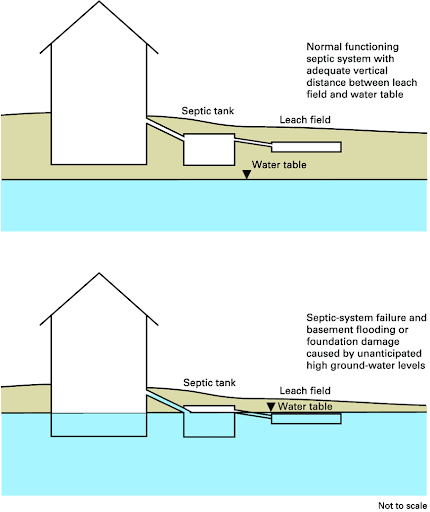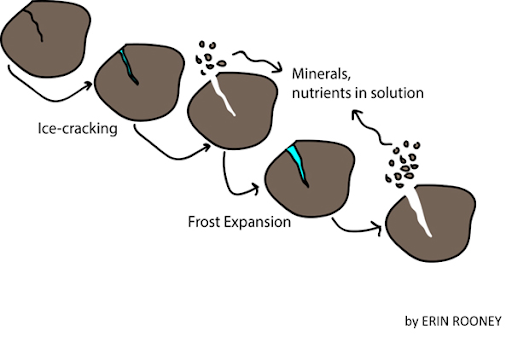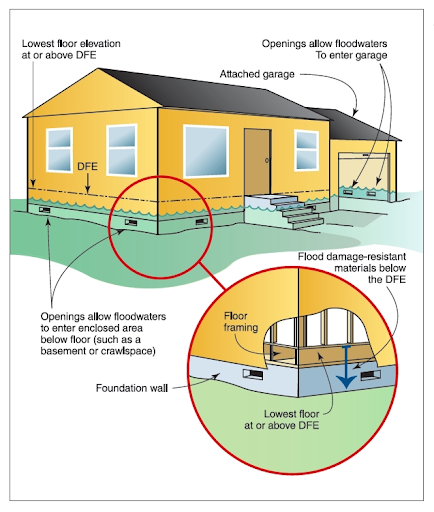- May 9, 2025
- Posted by: admin
- Category: Basement Questions

The Impact of Climate Change on Basement Flooding: How to Prepare Your Home
Climate change is significantly impacting various aspects of our environment, and one of the less-discussed effects is its contribution to basement flooding. As weather patterns become more unpredictable and extreme, the risk of basement floods increases, making it crucial for homeowners to take proactive measures. In this article, we will explore how climate change influences basement flooding and offer practical tips to protect your home.
For example, if you’re considering upgrading your property, professional consultation services like diplomarbeit schreiben lassen can also help with structured project planning, including home improvement documentation and detailed analysis. For instance, installing an air treatment system offered by reputable companies like The Basement Kings can help mitigate moisture-related issues in your basement. Additionally, investing in a high-quality basement dehumidifier can further reduce humidity levels and prevent mold growth.
However, if you’re considering finishing your basement to create additional living space, it’s important to evaluate the best time for such an undertaking. Factors such as construction logistics and potential weather-related risks should be taken into account. The Basement Kings have provided some valuable insights on when is the best time to finish a basement, whether it’s when the house is first built or after you have lived in it for a while.
By combining these preventive measures with expert guidance from professionals like The Basement Kings, you can safeguard your home from the increasing threat of basement flooding caused by climate change.
Understanding How Climate Change Affects Basement Flooding
1. Precipitation Patterns and Basement Flood Risks
Changing precipitation patterns due to climate change significantly impact the risk of basement flooding. The frequency and intensity of heavy rainfall events have increased, causing a higher volume of water to be directed towards residential areas. This can overwhelm drainage systems, leading to surface runoff that seeps into homes through cracks in the foundation or around windows and doors.
Several factors contribute to this phenomenon:
- Heavy Rainfall Events: Intense rainstorms can drop large amounts of water in a short time, overwhelming stormwater infrastructure. Urban areas with insufficient drainage systems are particularly vulnerable, as excess water pools on surfaces and Omega Planet Ocean Replica eventually finds its way into basements.
- Reduced Snowmelt Infiltration: Warmer winters result in less snow accumulation. When snow does melt, it often occurs rapidly, leading to increased runoff rather than gradual infiltration into the ground. This sudden influx of water can saturate the soil and elevate groundwater levels, increasing the likelihood of basement flooding.
Homeowners seeking effective strategies to manage these risks can refer to The Basement Kings’ comprehensive guide on battling basement leaks.
2. Rising Groundwater Levels: A Growing Concern for Basements

Climate change can significantly affect groundwater levels, making this a critical issue for homeowners concerned about basement flooding. As global temperatures rise, so do sea levels, contributing to higher underground water tables. This increase presents several challenges:
- Seepage Issues: Elevated groundwater levels can lead to water seeping through foundation walls and floors. This seepage is especially problematic in areas with high soil saturation.
- Hydrostatic Pressure: Increased groundwater creates hydrostatic pressure against basement walls. Over time, this pressure can cause cracks and structural damage, allowing more water to infiltrate.
- Soil Saturation: Consistently high rainfall or poor drainage can keep the soil saturated for extended periods, exacerbating hydrostatic pressure and contributing to long-term moisture issues within basements.
Higher groundwater levels also correlate with changing precipitation patterns—another factor driven by climate change. Intense rainstorms and prolonged droughts both contribute to fluctuating groundwater tables:
- Heavy Rainfall Events: Sudden downpours can saturate the ground quickly, overwhelming drainage systems and causing water to accumulate around your home’s foundation.
- Prolonged Droughts: Extended periods of drought can temporarily lower groundwater levels, but when heavy rains follow, the ground may be less absorbent, leading to increased runoff and potential basement flooding.
Understanding these dynamics is crucial for effective flood mitigation strategies. By recognizing how climate change impacts groundwater levels, homeowners can better prepare their properties against potential basement flooding risks.
For instance, homeowners planning to build a basement in clay soil should be aware that it is no longer impossible thanks to advancements in construction techniques and materials. Furthermore, staying informed about the latest developments in basement construction and maintenance is essential. Regularly checking out informative resources like The Basement Kings’ blog will provide valuable insights into best practices and emerging trends.
It’s important to note that rules and codes related to basements may vary across different regions. Homeowners in Texas, for example, need to be aware that rules and codes related to basements are not the same everywhere in the state. Such knowledge will enable them to make informed decisions and ensure compliance with local regulations while constructing or renovating their basements.
For more detailed information and expert solutions, visit The Basement Kings.
To address such seepage issues effectively, homeowners can explore crystalline waterproofing solutions provided by The Basement Kings.
3. The Impact of Freeze-Thaw Cycles on Basement Foundation Stability
Freeze-thaw cycles are another consequence of climate change that threatens basement integrity. These cycles involve repeated freezing and thawing of water within the soil surrounding a home’s foundation, which can lead to structural damage over time.
Here’s how it works:
- Expansion and Contraction: Water expands when it freezes, exerting pressure on the surrounding soil and structures. As temperatures rise and the ice thaws, contraction occurs, creating voids where soil settles unevenly.
- Foundation Cracks: Over time, these alternating pressures cause cracks in foundation walls. These cracks become entry points for water during subsequent thaw periods, increasing the risk of basement flooding.
Homeowners interested in understanding common causes of basement leaks and exploring repair solutions can refer to this comprehensive guide from The Basement Kings.
Understanding these mechanisms is crucial for homeowners looking to mitigate basement flood risks associated with climate change. Proactive measures must be taken to safeguard properties against these evolving threats.
3. The Impact of Freeze-Thaw Cycles on Basement Foundation Stability

Freeze-thaw cycles are another consequence of climate change that threatens basement integrity. These cycles involve repeated freezing and thawing of water within the soil surrounding a home’s foundation, which can lead to structural damage over time.
How Freeze-Thaw Cycles Happen:
- Water Infiltration: During warmer periods, water seeps into small cracks and pores in the foundation.
- Freezing: As temperatures drop, this water freezes, expanding by approximately 9%. This expansion exerts pressure on the surrounding materials.
- Thawing: When temperatures rise again, the ice melts, leaving voids where it expanded. This cycle repeats with each temperature fluctuation.
The Effects on Foundation Walls:
- Expansion and Contraction: Water expands when it freezes, exerting pressure on the surrounding soil and structures. As temperatures rise and the ice thaws, contraction occurs, creating voids where soil settles unevenly.
- Foundation Cracks: Over time, these alternating pressures cause cracks in foundation walls. These cracks become entry points for water during subsequent thaw periods, increasing the risk of basement flooding.
- Structural Integrity: Repeated freeze-thaw cycles can weaken the structural integrity of the basement walls, making them more susceptible to water infiltration during thaws.
- Hydrostatic Pressure: The combination of rising groundwater levels and compromised foundation stability due to freeze-thaw cycles increases hydrostatic pressure on basement walls.
Understanding these mechanisms is crucial for homeowners looking to mitigate basement flood risks associated with climate change. Proactive measures must be taken to safeguard properties against these evolving threats.
Homeowners interested in understanding common causes of basement leaks and exploring repair solutions can refer to this comprehensive guide from The Basement Kings. Consider exploring professional solutions offered by The Basement Kings to address potential freeze-thaw damage effectively. By addressing such vulnerabilities proactively, homeowners can mitigate the risks associated with climate-induced freeze-thaw cycles and ensure their basements remain dry and structurally sound. Additionally, The Basement Kings offer a range of products that can further enhance basement protection.
For more detailed information and expert solutions, visit The Basement Kings.
Key Aspects of Climate Change Impacting Basement Flooding
| Aspect | Description |
| Precipitation Patterns | Increased frequency and intensity of heavy rainfall events. |
| Heavy Rainfall Events | Intense rainstorms can overwhelm stormwater infrastructure, causing surface runoff and basement flooding. |
| Snowmelt Infiltration | Rapid snowmelt due to warmer winters increases runoff and groundwater levels, heightening flood risk. |
| Groundwater Levels | Rising temperatures raise underground water tables, increasing pressure on basement walls. |
| Hydrostatic Pressure | Groundwater pressure pushes water through foundation cracks, leading to dampness or flooding. |
| Soil Saturation | Consistently high rainfall or poor drainage keeps soil saturated, exacerbating hydrostatic pressure. |
| Freeze-Thaw Cycles | Repeated freezing and thawing of water in soil causes expansion and contraction, damaging foundations. |
| Foundation Cracks | Alternating pressures from freeze-thaw cycles create cracks, allowing water entry. |
| Structural Integrity | Weakened basement walls due to freeze-thaw cycles and hydrostatic pressure increase flood risk. |
Common Types of Basement Flooding
Understanding the various sources of basement flooding is crucial for homeowners aiming to protect their properties. Here are some common types:
1. River Flooding
When nearby rivers or streams overflow their banks, basements can quickly become inundated with water. This type of flooding is particularly problematic for homes located in floodplains or near large bodies of water.
2. Coastal Flooding
Homes in hurricane-prone regions face the risk of coastal flooding. Storm surges and high tides can push seawater inland, leading to significant basement flooding. This is especially relevant for properties situated along coastlines.
3. Flash Flooding
Characterized by its sudden and swift nature, flash flooding often results from heavy rainfall over a short period. Urban areas with poor drainage systems are particularly vulnerable to this type of flooding, which can overwhelm basements before homeowners have time to react.
4. Urban Flooding
A man-made problem caused by inadequate drainage systems in developed areas. Overburdened stormwater infrastructure can lead to water pooling on streets and seeping into basements, posing a significant risk during heavy rain events.
To implement effective prevention strategies against these different flooding sources, it’s essential to recognize them. For instance, homes vulnerable to river flooding should consider measures specific to that scenario such as installing flood barriers or waterproofing the basement walls against rising water levels.
Similarly, those residing in regions prone to coastal flooding may need to take extra precautions like elevating electrical systems and using water-resistant materials during basement renovations.
Homeowners in areas susceptible to flash flooding should focus on improving their property’s drainage system and consider investing in sump pumps or interior waterproofing systems that can swiftly redirect excessive water away from the basement.
Meanwhile, properties affected by urban flooding should explore long-term solutions such as advocating for better stormwater management in their community or retrofitting their homes with green infrastructure to absorb excess water.
If you’re uncertain about the most effective prevention strategies for your specific situation, it’s wise to seek professional guidance from experts like The Basement Kings. Their specialized knowledge in basement design and waterproofing solutions can make a substantial difference in safeguarding your home.
The Role of Home Design in Basement Flood Mitigation

In the face of climate change, strategic basement design becomes crucial for mitigating flood risks. One effective method is incorporating flood vents in below-grade areas. These vents are designed to allow water to flow freely through enclosed spaces during flood events, thereby equalizing the pressure on both sides of the walls and reducing the risk of structural damage.
How Flood Vents Work
Flood vents operate based on a simple yet effective mechanism:
- Pressure Equalization: During a flood, water exerts significant pressure on basement walls. Flood vents allow water to enter and exit the basement, balancing the internal and external pressure.
- Debris Passage: Quality flood vents are designed to let not just water but also debris flow through, preventing clogging and ensuring continuous functionality.
- Automatic Activation: Advanced flood vents automatically open when they come in contact with floodwaters, providing hands-free operation during emergencies.
Benefits of Flood Vents
Several benefits make flood vents an essential component of modern basement design:
- Structural Integrity: By equalizing water pressure, flood vents prevent potential cracks and foundational shifts, preserving the structural integrity of your home.
- Reduced Repair Costs: Minimizing structural damage translates into lower repair costs post-flooding.
- Regulatory Compliance: In many regions, including those prone to significant flooding, incorporating flood vents is a building code requirement.
For more detailed insights on innovative basement design solutions and engineering strategies that can further mitigate flooding risks, visit The Basement Kings’ Engineering page.
Installation Considerations
When planning to install flood vents:
- Location: Position them strategically around your basement’s perimeter at appropriate heights to ensure optimal functionality.
- Type and Size: Choose vents that match your specific needs—automatic or non-automatic—and ensure they are adequately sized for your basement area.
- Professional Advice: While DIY installation is possible, consulting with professionals like The Basement Kings ensures that you get expert recommendations tailored to your home’s unique requirements.
2. Raised Landscaping Beds: A Barrier Against External Water Intrusion
Another impactful strategy in basement design involves using raised landscaping beds or berms around your home’s perimeter. This technique diverts surface water away from the foundation, effectively reducing the likelihood of water intrusion into your basement.
Implementing Raised Landscaping Beds:
- Design and Placement: Create raised beds with appropriate slopes directing water away from your house. Use native plants that can help absorb excess moisture.
- Materials: Utilize materials such as gravel or mulch which assist in drainage while adding aesthetic appeal.
- Maintenance: Regularly maintain these beds to ensure they remain effective barriers against surface runoff.
By incorporating these advanced design elements into your home’s architecture, you not only safeguard your property against immediate flooding risks but also enhance its resilience against the growing impacts of climate change. For more comprehensive guidance on safer storm cellars and underground shelters that complement these techniques, explore Basement Kings’ resources.
Key Advantages of Raised Landscaping Beds:
- Water Diversion: Strategically placed raised beds channel rainwater and melting snow away from your foundation, keeping your basement dry.
- Erosion Control: These features stabilize the soil around your property, minimizing erosion that could otherwise lead to basement flooding.
- Enhanced Aesthetics: Apart from their functional benefits, raised beds enhance the visual appeal of your landscaping.
When planning for raised landscaping beds, it’s essential to consider flood-resistant design features. Proper elevation of utilities and the use of water-resistant materials during new construction or renovation projects can further safeguard your home against climate change impacts.
To learn more about these design elements, visit The Basement Kings’ online magazine.
For specialized products that aid in maintaining a dry and healthy basement environment, consider exploring air treatment solutions offered by The Basement Kings. These products can complement the effectiveness of raised landscaping beds by ensuring optimal air quality within your basement.
To fully optimize your flood prevention strategy, accurate implementation and expert advice on unique measurement techniques are crucial. Visit The Basement Kings’ measurement products page for innovative tools that provide precise measurements tailored to your specific needs.
Incorporating these design elements into your landscaping strategy ensures a proactive approach to flood prevention. Taking these measures not only protects your investment but also promotes sustainable living practices in light of changing precipitation patterns and rising groundwater levels.
Conclusion
It’s important to be proactive in protecting your home against basement floods, especially with the changing climate. By implementing the preparation measures discussed in this article, such as ensuring proper basement insulation and installing sump pumps, you can significantly reduce the risk of basement flooding.
If you prefer professional help, The Basement Kings is a reputable company that offers specialized services to address and prevent basement flooding issues. They have a team of experienced contractors who specialize in basement concrete repair and fixing basement leaks.
Remember that individual actions are crucial, but collective efforts to combat climate change are equally important. It’s vital to support initiatives and policies aimed at reducing the impacts of climate change and adapting to them for a sustainable future.
Together, we can make a meaningful difference in reducing the risks associated with basement flooding and other climate-related challenges.
Frequently Asked Questions
What are the various ways in which climate change can contribute to basement flooding?
Climate change can contribute to basement flooding through changing precipitation patterns, rising groundwater levels, and the impact of freeze-thaw cycles on foundation integrity.
How do changing precipitation patterns affect basement flood risks?
Changing precipitation patterns can make basements vulnerable to flooding by causing more intense rainstorms or prolonged droughts, leading to an increased risk of basement floods.
What is the relationship between rising groundwater levels and basement flood risks?
Rising groundwater levels can lead to seepage issues and hydrostatic pressure on basement walls, increasing the risk of basement floods.
How do freeze-thaw cycles impact basement foundation stability?
Freeze-thaw cycles have the potential to cause cracks in foundation walls, allowing water to infiltrate basements during thaws, thus compromising basement foundation stability.
What are the common types of basement flooding that homeowners may encounter?
Homeowners may encounter river flooding, coastal flooding, flash flooding, and urban flooding as different sources of basement flooding.
How can flood vents help mitigate basement flood risks?
Flood vents can help equalize water pressure during a flood event, reducing the risk of structural damage in basements and mitigating the impact of floods.
